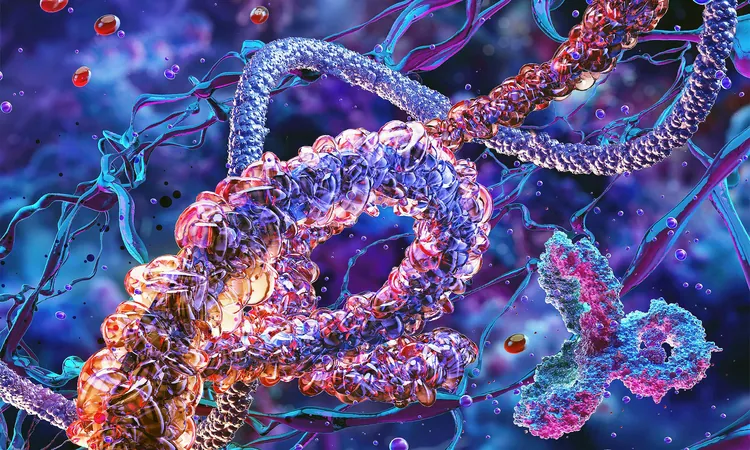
Breakthrough Discovery: Scientists Uncover How Life on Earth May Have Begun!
2025-08-31
Author: Jia
The Quest to Unravel Life's Origins
Life as we know it depends on proteins, essential for everything from cell repair to immune defense. But how were the very first proteins created in a world lacking complex cellular machinery? A groundbreaking new study has unveiled a simple chemical process that may reveal the secret behind the origin of life on our planet.
A Simple Reaction Leads to Life's Building Blocks
Led by Professor Matthew Powner from University College London, the research focuses on prebiotic chemistry, exploring how fundamental components of life could have formed. The team demonstrated that ribonucleic acid (RNA)—the molecule responsible for storing and transmitting genetic information—can chemically bond with amino acids, the building blocks of proteins, through a straightforward reaction occurring in water.
Energized Amino Acids Make the Connection
This innovative process involves transforming amino acids into a more reactive form, allowing them to connect with RNA at precise locations, all without the need for enzymes. Remarkably, the reaction favors the ends of double-stranded RNA, helping to maintain the order of amino acid sequences and avoiding chaos.
The Role of Sulfur in Early Life Chemistry
The researchers turned their attention to thiols—a sulfur-containing compound involved in metabolism. These compounds, transformed into thioesters, can facilitate essential reactions in water, making them likely candidates for driving early protein chemistry on Earth. Previous studies have hinted that such sulfur compounds were present before life began.
From Chemistry to Function: The Path to Proteins
In their findings, the team identified a mechanism that leads to the attachment of amino acids to RNA, forming aminoacyl RNA capable of evolving into short peptide chains. Dr. Jyoti Singh emphasized the significance of using thioesters—molecules crafted from Coenzyme A, found in all living cells today. This discovery could bridge the elusive gap between metabolism, genetic coding, and protein synthesis.
Where Did It All Happen? The Ideal Conditions
This fascinating chemistry unfolds in near-neutral pH water, suggesting that the birth of life might have occurred in smaller bodies of water rather than the open ocean. Researchers highlighted the role of minerals and cycles of freeze concentration, where ice forms and concentrates solutes, accelerating these vital reactions.
Connecting Chemistry and Biology
Unlike modern cells that utilize ribosomes to manufacture proteins from RNA instructions, this newly discovered process hints at a time when RNA alone might have facilitated the bonding of amino acids. This approach supports the concept of an 'RNA-peptide world' where RNA and short peptides co-evolved, laying the groundwork for more complex biological systems.
Hints at the Modern Genetic Code
The research provides intriguing insights into how early RNA potentially mapped its sequences to specific amino acids, a key step towards establishing the genetic code that governs life today. By unraveling these simple yet effective rules, the study sets the stage for understanding how primitive life forms could have evolved into today's complex organisms.
Endless Possibilities in the Study of Life's Origins
This pioneering study, published in the prestigious journal "Nature," opens new avenues in our understanding of life's beginnings. With each discovery, we inch closer to answering one of humanity's oldest questions: how did life emerge from non-life? Stay tuned for more thrilling revelations in our quest to understand the origins of life on Earth!
 Brasil (PT)
Brasil (PT)
 Canada (EN)
Canada (EN)
 Chile (ES)
Chile (ES)
 Česko (CS)
Česko (CS)
 대한민국 (KO)
대한민국 (KO)
 España (ES)
España (ES)
 France (FR)
France (FR)
 Hong Kong (EN)
Hong Kong (EN)
 Italia (IT)
Italia (IT)
 日本 (JA)
日本 (JA)
 Magyarország (HU)
Magyarország (HU)
 Norge (NO)
Norge (NO)
 Polska (PL)
Polska (PL)
 Schweiz (DE)
Schweiz (DE)
 Singapore (EN)
Singapore (EN)
 Sverige (SV)
Sverige (SV)
 Suomi (FI)
Suomi (FI)
 Türkiye (TR)
Türkiye (TR)
 الإمارات العربية المتحدة (AR)
الإمارات العربية المتحدة (AR)